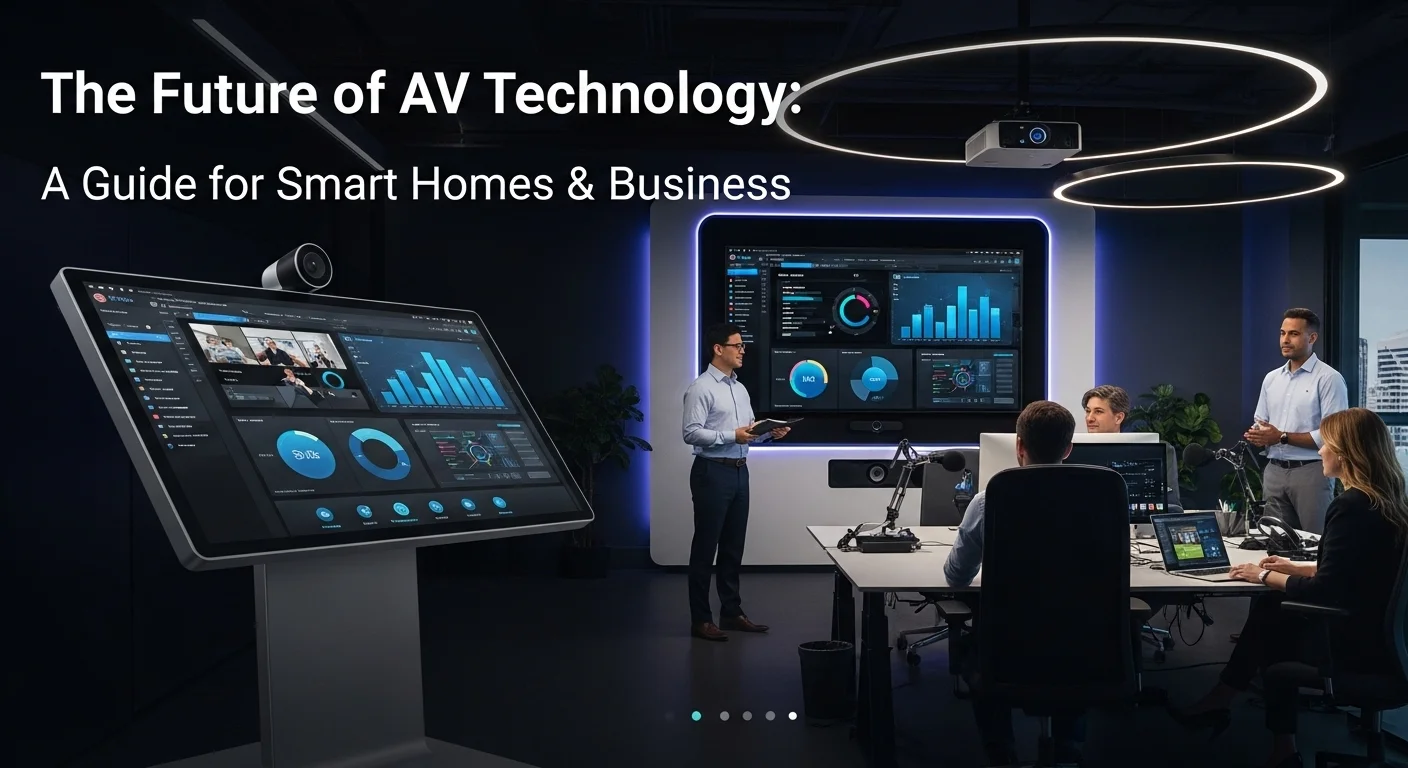AV Technology Explained: A Real-World Guide for Your Home and Business

Executive Summary
I've spent years in the trenches of AV integration, untangling wires in corporate boardrooms and programming smart homes to perfection. What I've seen is that audiovisual (AV) technology has quietly become the backbone of our daily lives. It’s not just about fancy TVs anymore. In business, it's the key to making hybrid work actually work. At home, it’s what turns a house into an intelligent, responsive space that brings comfort and entertainment. This evolution is happening because AV now speaks the same language as IT, the cloud, and even AI. Getting your head around AV isn't just for techies; it's for anyone who wants to work smarter and live better. In this guide, I'll break down the core pieces, from how control systems like Control4 create amazing smart homes to how businesses can use automation to get ahead.
Table of Contents
Table of Contents
- So, What Exactly is AV and Why Does It Matter?
- The Magic of Smart Living: Home Entertainment's Big Leap
- Beyond the Boardroom: How AV Powers Modern Business
- The Tech Deep Dive: AV for Business and Home
- The Blueprint for a Truly Smart Home
- Designing Smart Solutions for Business Spaces
- Practical Tips to Get the Most from Your AV Tech
- Fine-Tuning Your Smart Home Experience
- Future-Proofing Your AV Strategy at Home and Work
So, What Exactly is AV and Why Does It Matter?
At its heart, audiovisual (AV) technology is the art and science of how we use sound and visuals to communicate and connect. But let's be honest, that sounds a bit academic. In my world, AV is what makes a video call with a team member across the globe feel like you're in the same room. It’s the magic behind a home theater that gives you goosebumps, and the seamless control that makes a smart home feel truly intelligent. Today's AV isn't just a projector and a screen; it's a complex, integrated system of hardware and software. Its importance has exploded because everything is going digital. For businesses, a solid AV setup is the foundation of a modern conference room and the key to clear communication. For our homes, it’s what transforms a living room into an entertainment hub. A huge shift I've witnessed firsthand is the move to networked AV, or AV over IP (AVoIP). This means AV systems now live on the same IT network as your computers. This gives us incredible flexibility, but it also means we have to think about things like network stability and cybersecurity—something that wasn't a concern a decade ago. A well-designed system, whether at home or in the office, should feel effortless. Behind the scenes, sources (like a laptop or media player), processors, and endpoints (like displays and speakers) are all working together. My job, and the goal of any good AV setup, is to hide that complexity so you can just press a button and have it work.
The Magic of Smart Living: Home Entertainment's Big Leap
Nowhere is the AV revolution more personal than in our own homes. The idea of a 'smart home' has gone from a futuristic dream to a tangible reality, changing how we live. The brain of it all is a home AV control system. Think of it as the conductor of an orchestra, making sure all your connected devices—audio, video, lighting, climate, security—play in perfect harmony. The whole point of home automation is to create experiences that make life easier and more enjoyable. Imagine this: you say 'Movie Night,' and with that one command, the lights dim to the perfect level, the blinds close, the projector screen lowers, and your favorite streaming service fires up. That's the power of a well-programmed automation system. In my experience installing high-end systems, platforms like Control4 are industry leaders for a reason. A Control4 setup is more than just an app; it's a robust ecosystem professionally installed to be incredibly reliable and compatible with thousands of different devices. It gives you one simple interface—on a touchscreen, a sleek remote, or your phone—to manage everything. For example, with a system like this, you can have a 'Party' mode that plays the same upbeat playlist throughout the house, or you can have different music playing in every room. It can even show you a video feed of your front door on your TV screen when the doorbell rings. This is what separates a true smart home from a house that just has a few smart plugs. It’s not just about convenience, either. These systems are genuinely useful. They help save energy by automatically adjusting lights and thermostats, and they boost security by letting you check in on your home from anywhere in the world. Ultimately, good AV home automation makes technology serve you, simplifying your routines and creating a space that’s perfectly tuned to your life.
Beyond the Boardroom: How AV Powers Modern Business
In the corporate world, I've seen AV technology evolve from a 'nice-to-have' to an absolute necessity for staying competitive. With so many companies embracing hybrid work, advanced AV is the glue that holds teams together. It's no longer acceptable to have grainy video and garbled audio; we need high-quality conferencing systems that make remote employees feel just as present as those in the room. I've installed systems with smart cameras that automatically follow whoever is speaking and microphones that filter out distracting background noise—these features make meetings more equitable and productive. But it's not just about meetings. AV is transforming how businesses communicate everywhere. Digital signage in a retail store can deliver targeted ads, while in an office, it can display corporate news or real-time performance dashboards. Massive video walls in company lobbies create powerful first impressions. I’ve also helped companies build interactive training rooms that make learning more engaging and effective. We're now even seeing AV merge with building management to create truly 'smart' offices. For instance, occupancy sensors can tell the system to power down the displays and lights in a room when it's empty, which is great for the company's budget and sustainability goals. Managing all of this can be complex, which is why cloud-based platforms are becoming so popular. They allow an IT team to monitor and troubleshoot all the AV gear across the entire company from one place. In today's digital landscape, a smart AV strategy isn't just a tech decision; it's a business decision that leads to better collaboration, stronger engagement, and more efficient operations.

The Tech Deep Dive: AV for Business and Home
When you start to peel back the layers of modern AV, you find some seriously impressive technology at work. The biggest game-changer, in my opinion, has been AV over IP (AVoIP). This simply means we're now sending high-definition audio and video over the same kind of network that your computers use. It’s a huge deal because it makes systems incredibly scalable and flexible compared to the old way of doing things with rigid, expensive hardware. You can create a system that covers a single room or an entire corporate campus. But, and this is a big but, putting AV on the IT network means you have to get serious about cybersecurity. Every networked speaker or display is a potential door for an attack. The first thing I always recommend is putting all AV traffic on its own separate network (a VLAN) to wall it off from sensitive company data. Using strong passwords, keeping device firmware updated, and encrypting signals are all non-negotiable best practices. It’s a shared responsibility between the manufacturer, the installer like me, and the client's IT team. Another exciting frontier is the blend of Artificial Intelligence (AI) and cloud computing with AV. AI is making our systems smarter. In meeting rooms, AI-powered cameras can automatically frame the person speaking, and AI noise cancellation can erase the sound of a barking dog from a video call. It’s a massive improvement to the user experience. Voice control is another AI-driven feature that makes it easy to manage a room without touching a thing. The cloud, on the other hand, is changing how we manage AV systems. A marketing manager can update digital signs in stores across the country from their laptop. As an integrator, I can use cloud platforms to remotely monitor a client's system and often fix a problem before they even know it exists. This has led to a model called AV-as-a-Service (AVaaS), where businesses can pay a subscription for up-to-date technology and support, which is a great way to avoid huge upfront costs.
The Blueprint for a Truly Smart Home
Building a reliable and truly integrated smart home is a craft. It’s about creating a single, cohesive system, not just collecting a box of smart gadgets. The absolute bedrock of any good AV home automation project is a rock-solid network. With everything from 4K TVs streaming content to security cameras and smart lighting, your home network is working harder than ever. That's why I always start with a professional-grade network using high-quality routers, switches, and wireless access points to ensure there's enough speed and coverage for every device, everywhere in the house. This is where a pro can really make a difference. At the core of a high-performance smart home is a powerful control system. This is the territory of dedicated platforms like Control4, Crestron, or Savant. These are the operating systems for your home. A Control4 ecosystem, for instance, uses a central 'brain' or controller that communicates with all your other devices. This allows for the kind of sophisticated automation that feels like magic. For example, a 'Good Morning' scene can be programmed to slowly raise the lights to mimic the sunrise, adjust the thermostat, open the blinds, and turn on the morning news—all triggered by a single button press. The technical design often involves centralizing your equipment. Instead of having a cable box and an Apple TV in every room, we house all the sources in a single equipment rack. A video matrix then sends any source to any TV in the home. It’s the same for audio. This keeps your living spaces clean and uncluttered. The final, crucial piece is the user interface. It has to be simple. Whether it's a sleek handheld remote, a wall-mounted touchscreen, or an app, it should be intuitive enough for everyone in the family to use. A well-designed system hides all the technical complexity. You shouldn't have to think about inputs; you should just see a button that says 'Watch Netflix'. This combination—a robust network, a central controller, and a simple interface—is the blueprint for turning a house into an intelligent, responsive, and enjoyable home.
Designing Smart Solutions for Business Spaces
When I design an AV solution for a business, my first step is always to listen. I need to understand their goals. Are they trying to make collaboration easier? Impress clients? Streamline their training? The technology must serve a business purpose. For small 'huddle rooms,' the goal is usually simplicity. I'll recommend an all-in-one soundbar with a built-in camera and mic, a commercial-grade display, and an easy way for people to share their screens wirelessly. For larger boardrooms, things get more complex. We might use multiple displays, advanced ceiling microphones that capture clear audio from anywhere in the room, and smart cameras. A key focus here is 'meeting equity'—making sure remote participants have just as good an experience as people in the room. This means thinking carefully about camera angles and microphone placement so everyone can be seen and heard clearly. Digital signage is another powerful tool for businesses. A well-designed system is a dynamic communication network. It's built with media players connected to screens, all run by a central Content Management System (CMS). This lets an administrator schedule and push out content—like marketing videos, company announcements, or safety alerts—to hundreds of screens instantly, no matter where they are. In every business project, three things are paramount: reliability, security, and manageability. We use commercial-grade gear that's built to run all day, every day. As I mentioned, security is a huge concern, so we work with the IT department to make sure the AV system is locked down. And finally, remote management tools are essential for the IT team to keep everything running smoothly without having to physically visit every room.

Practical Tips to Get the Most from Your AV Tech
To really get the most out of your AV technology, whether at work or at home, you need to think strategically. For businesses, the single most important tip I can give is to treat AV as a core part of your IT infrastructure, not an afterthought. This means getting your IT and cybersecurity folks involved right from the start of any project. Another huge one is user training. I've seen incredibly powerful systems go unused because employees found them intimidating. Simple guides and quick training sessions make a world of difference in adoption and reduce headaches for the support team. It’s also smart to have a lifecycle plan for your equipment. Technology moves fast. Planning for regular maintenance, updates, and eventual replacement ensures your systems stay secure and effective for the long haul. And if you're outfitting multiple rooms, try to standardize your equipment. Using a consistent setup across all your spaces makes it easier for people to use, simplifies maintenance, and can even save you money. For any significant project, my best advice is to partner with a qualified AV integrator. Look for a company with certified professionals and a solid portfolio. A good partner doesn't just install the gear; they design a solution that fits your needs and provides support after the job is done. Finally, keep an eye on the future. Technologies like 8K video and AR/VR for collaboration are coming. Being aware of these trends can help you make smarter, more future-proof investments today.
Fine-Tuning Your Smart Home Experience
Once your smart home system is installed, the real fun begins: personalizing it. One of the first things you should do is have your home theater professionally calibrated. A technician can fine-tune your display's color and your audio system's speaker levels to make sure you're experiencing movies and music exactly as the creators intended. It's a night-and-day difference. Next, dive into creating custom scenes with your control system. This is how you make the house truly yours. For example, create a 'Cooking' scene that sets the kitchen lights to be bright, plays your favorite cooking playlist, and turns the kitchen TV to the Food Network. Or a 'Goodnight' scene that, with one tap, turns off every light and TV in the house, locks the doors, and adjusts the thermostat. If you have a system like Control4, you can often create or tweak these scenes yourself right from the app. It's also vital to keep your system healthy. The simplest thing you can do is reboot your router and modem every month or so—it solves more problems than you'd think! Also, ensure your integrator keeps the firmware on all your devices updated. These updates often contain critical security patches as well as new features. A common question I get is whether to go DIY or hire a professional. DIY systems are great for simple tasks, but if you want a truly integrated home where your AV, lighting, security, and climate systems all talk to each other seamlessly, investing in a professional integrator is the way to go. We have the tools and experience to design a robust system that won't become a source of frustration down the road.
Future-Proofing Your AV Strategy at Home and Work
The world of AV technology is always changing, so it's smart to think about the future when you're investing in it today. For businesses, this means designing systems that are flexible. Moving to an AV over IP network is a great step, as it's much easier to expand or reconfigure than older systems. I also advise clients to look at software-based solutions and service models, as these can be updated continuously without needing to rip and replace hardware. The role of AI in AV is only going to get bigger. We'll see meeting rooms that can automatically create summaries of what was discussed and digital signs that can analyze viewer engagement. So, when choosing new gear, it's worth asking about its AI capabilities. For your home, future-proofing follows similar rules. If you're building or renovating, run extra high-quality cabling like Cat6a or even fiber optic. The bandwidth you think you need today will seem small in a few years, especially with 8K video on the horizon. When choosing a control system, pick one like Control4 that is known for working well with thousands of other products. This makes it more likely that new gadgets you buy in the future can be easily integrated into your smart home. The very concept of the smart home will continue to expand, with more focus on wellness—like lighting that adjusts throughout the day to support your natural sleep cycle. By focusing on a strong network foundation, choosing scalable systems, and keeping an eye on what's next, you can build an AV strategy that will serve you well for years to come.
Expert Reviews & Testimonials
Sarah Johnson, Business Owner ⭐⭐⭐
The information about Av is correct but I think they could add more practical examples for business owners like us.
Mike Chen, IT Consultant ⭐⭐⭐⭐
Useful article about Av. It helped me better understand the topic, although some concepts could be explained more simply.
Emma Davis, Tech Expert ⭐⭐⭐⭐⭐
Excellent article! Very comprehensive on Av. It helped me a lot for my specialization and I understood everything perfectly.



